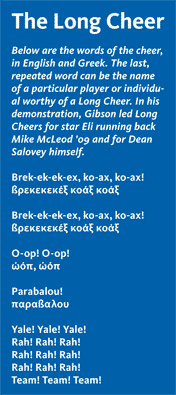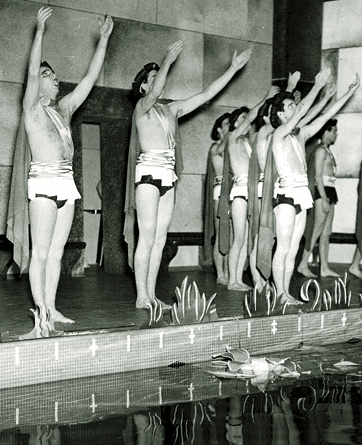
 |
||
The Yale Alumni Magazine is owned and operated by Yale Alumni Publications, Inc., a nonprofit corporation independent of Yale University. The content of the magazine and its website is the responsibility of the editors and does not necessarily reflect the views of Yale or its officers. |
Comment on this article
If you walked through the Woolsey Hall Rotunda on May 31, on Saturday of the first reunion weekend, just after the president’s speech, you might have encountered an event that was not on the reunion schedule. There, in front of a video crew and whoever happened to pass by, two full-grown men were jerking their arms to and fro, bending down, leaping up, and shouting a peculiar incantation:
Those of you who are Yale College alumni over the age of, say, 70, already know what I’m talking about. The liturgical dancers were performing the Long Cheer, a Yale ritual that was born in the 1880s and survived until—well, we’re not sure, but probably the 1960s, when so many vestiges of Old Yale bit the dust. The two men were teacher and student: Frank Gibson ’49, a former Yale cheerleader, was showing Yale College dean Peter Salovey ’86PhD the fine points of a cheer that was once shouted by thousands at the Yale Bowl.
Robert H. O’Connor ’45W, ’48E, would like to see that happen again. As football manager in 1947, O’Connor was responsible for appointing the head cheerleader, and he chose Gibson. Like most Yalies of his time, O’Connor knew the Long Cheer, but he never really knew it until the day he was summoned to the office of then-university secretary Carl Lohmann ’09, who complained to him that the student body had forgotten the proper way to do the Long Cheer. “He came out from behind his desk and showed me,” recalls O’Connor. Gibson himself remembers learning the intricacies of the cheer, from Jonathan Edwards College master Robert Dudley French, not long after he arrived as a freshman in 1944. (Click here to read Gibson’s story of how it happened.) As students of ancient Greek will know, the seemingly nonsensical words of the cheer have their origins in Aristophanes’ comedy The Frogs, written in about 405 BCE. “Brek-ek-ek-ex, ko-ax, ko-ax” is the sound a chorus of frogs makes as Charon ferries Dionysus across a lake in Hades. (If you don’t think frogs sound like that, by the way, try listening to Pelophylax ridibundus, a marsh frog common in Greece.) In January 1884, a group of sophomores studying their Greek got a little punchy and decided the frog chorus would make a great cheer. To the “Brek-ek-ek-ex, ko-ax, ko-ax” they added a couple of Charon’s lines: “o-op” (“avast”) and “parabalou” (“lay to”). A few months later, they introduced the cheer during a low point at a baseball game. It spurred the Bulldogs to victory and became a long-lasting part of the repertoire, acquiring a coda of staccato “Yale”s and “Rah”s somewhere along the way. (Click here for Judith Ann Schiff’s 1998 column about the cheer’s origin, and here to read the letters we got in response.) It was O’Connor who organized the Woolsey Hall lesson (which was to be a private one until the Yale Alumni Magazine heard about it and brought cameras). He had seen a photo of Salovey directing the Yale band at a hockey game, he says, and thought, “If he can do that, he can lead the Long Cheer.” O’Connor’s dream is that Salovey will lead a renaissance of the cheer among his student charges. If you want to learn the Long Cheer, watch our video as often as needed. The dean may need to consult it himself a few times between now and football season. Thank you for your article on the Yale cheer. Until now I thought what followed the frogs’ croak was gibberish, but thanks to your commentary, I found both words in my Liddle and Scott Greek-English Lexicon, dated Oxford, October 1871. “O-op” is translated as “the cry of the ‘keleustes’ to make the rowers stop pulling… The keleustes is the man who by his call (keleusma) gives the time to the rowers.” “Parabalou” is the imperative “Put to land!” Incidentally, there is no mention in the article that Monty Woolley ’11 directed a production of Aristophanes’ Frogs in the Yale swimming pool just before Pearl Harbor. Who knows? A stimulus for staging it may have been the then-popular Yale cheer “brek-ek-ek-ex.” There was another famous staging of The Frogs in the Payne Whitney pool in 1974 with songs by Stephen Sondheim—and Meryl Streep ’75MFA, Sigourney Weaver ’74MFA, and Christopher Durang ’74MFA in the chorus.—Eds.
Growing up with the Long Cheer I grew up with a family weaned on “Brek-ek-ek-exes.” My late mother also enjoyed an anti-Harvard dirge called “The Undertaker:”
Alas, “The Undertaker” is no longer heard in the Bowl. An earlier generation deemed it un-sportsmanlike, said Mother. Surely there’s a small book with the words and music, life and death, of Yale cheers. The Yale Glee Club, which includes “The Undertaker” in its Football Medley, offers for sale a recently updated edition of Songs of Yale that includes a number of traditional tunes, if not cheers.—Eds. |
|
|
|
|
|
|
|
|
|
©1992–2012, Yale Alumni Publications, Inc. All rights reserved. Yale Alumni Magazine, P.O. Box 1905, New Haven, CT 06509-1905, USA. yam@yale.edu |
||

